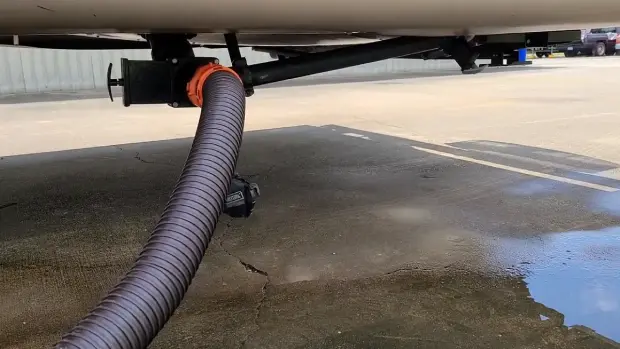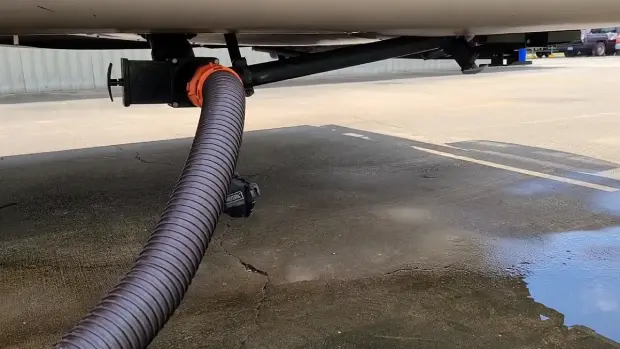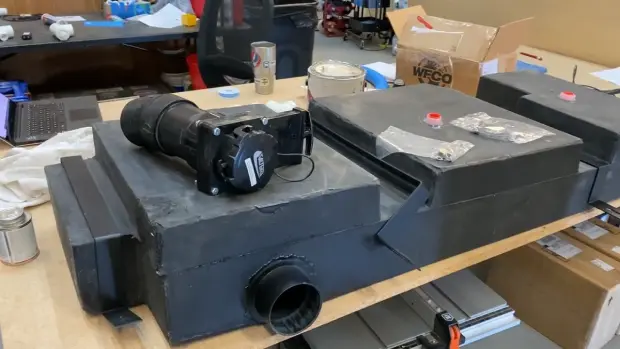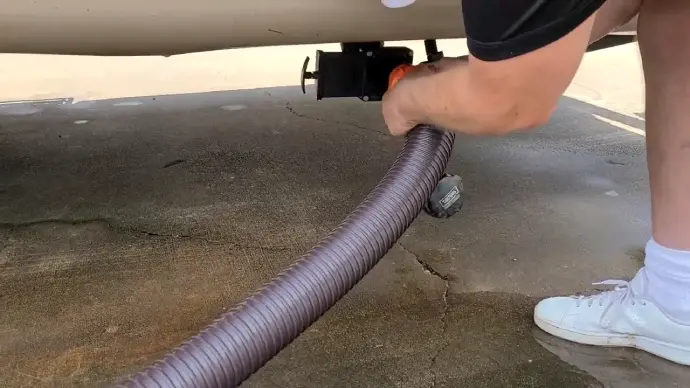Last Updated on June 11, 2023
Recreational vehicles provide a great opportunity to explore the country while enjoying some of the comforts of home. One essential feature of an RV is its gray tank, which holds all the water from sinks and showers in the vehicle.
However, the rate at which this tank fills up can vary considerably depending on various factors. The capacity of your gray tank, the size of your RV, and the number of people using it all affect how quickly the tank fills up.
Even the simplest of activities can have lasting consequences – especially regarding RV gray water tanks. So what kind of impact do your daily habits and tank size have on how quickly these waste vessels fill up?
We jump into this important topic in our article, exploring different ways you could be unintentionally speeding (or slowing) the refill process. Knowing these factors can help you plan your RV trip better and get the most out of your travel experience.
Factors That Affect How Fast RV Gray Tanks Fill Up

Your gray tank is critical to any adventure if you’re an RV enthusiast. It stores water from showers and sinks until it’s ready to be discharged, but how full this tank gets depends on many variables. Here are some important considerations when managing your travel setup:
#1: The Capacity Of Your Gray Tank
The capacity of your gray tank is an important consideration when it comes to RV living. It determines how long you can stay off-grid without dumping the wastewater. Gray tanks are designed to hold the water from sinks, showers, and other similar sources. They differ in size depending on your RV or trailer type.
To put things into perspective, a typical Class A motorhome has a gray tank with a capacity of around 60 gallons. Smaller travel trailers may only have 20-30 gallon tanks. The rate at which these tanks fill up depends on several factors, such as the number of people using them and their habits (e.g., taking long showers).
Generally speaking, if you’re traveling solo and practicing conservation methods like navy showers, you can expect your gray tank to last for about two weeks before emptying.
#2: The Size Of Your Rv And Users
The size of your RV and its number of occupants can greatly impact how fast your gray tank fills up. For those traveling solo or as a couple in a smaller RV, the gray tank may not fill up as quickly compared to larger families with more individuals producing wastewater.
The average capacity for an RV gray tank ranges from 20-80 gallons depending on the type of RV and its manufacturer. While this may seem like ample space, it is important to remember that showering frequency and dishwashing habits can affect how often you dump your tanks.
#3: The Type Of Activities You Do In Your Rv
Activities in your RV can greatly affect how quickly or slowly the gray tank fills up. The type of activities you engage in while living on board will determine how often you’ll need to empty this tank. Some activities, such as showering and washing dishes, like brushing teeth or cooking, generate more gray water than others.
The gray tank inside your RV will probably fill up faster if you take frequent showers or have multiple people using the facilities.
If you spend a lot of time cooking elaborate meals that require lots of dishwashing, it’s also reasonable to expect your gray tank to fill up quicker than if you’re eating out most nights. Various factors contribute to how fast an RV’s gray tanks fill up.
But by being mindful of these factors and adopting practices that minimize waste generation, you can extend the amount of time before emptying them again. Consider taking navy-style showers where you turn off the faucet when lathering.
How Often Do You Dump Your Gray Tank?
Living life on the open road means knowing exactly when and how to manage your gray tank. Although factors such as size, occupants, and frequency of use can all influence this process, careful consideration will help you find a schedule that suits your lifestyle perfectly.
Let’s look at some data to understand better how often you may need to dump your gray tank. In a survey conducted among RVers, respondents were asked how many days they could go before emptying their gray tanks.
| Number of Days | Percentage |
| 1-2 | 28% |
| 3-4 | 48% |
| 5-6 | 15% |
How To Monitor Your RV Gray Tank Level?

It pays to keep a close eye on your RV’s gray tank levels. Fortunately, there are plenty of ways to monitor when it needs emptying so you can avoid the nasty consequences of an overflowing tank or those rancid odors.
1. Gray Tank Indicators
Gray tank level monitoring is one of the most common RV issues. In order to address this concern, it is important to discuss the role of gray tank indicators in tracking the amount of wastewater accumulated by an RV’s gray water system.
Gray tank indicators are designed to visually represent the current level of wastewater stored in an RV’s gray tank. These sensors operate using electrical signals that measure fluid volume within the storage container.
Users can easily determine whether or not they need to dump their tanks before continuing their journey by reviewing the data collected by these sensors.
Note: Though gray tank indicators can help monitor your wastewater levels, they’re not always 100% accurate because of things like sensor malfunctions and debris.
2. Gray Tank Monitoring Apps
In addition to gray tank indicators, various apps are available for monitoring your RV’s wastewater levels. Gray tank monitoring apps are designed to provide users with real-time updates on their gray water system, allowing them to easily track the amount of wastewater that has accumulated over time.
These apps operate using Bluetooth or Wi-Fi connectivity and can be accessed via a mobile device such as a smartphone or tablet. They typically offer features such as customizable alerts, detailed reporting, and historical data tracking, all of which can help you better manage your RV’s wastewater disposal needs.
However, it should be noted that not all gray tank monitoring apps are created equal. Some may require additional hardware installations to function properly, while others may have limited compatibility with certain RV models.
How to Reduce Gray Tank Usage?
There are several ways to reduce the amount of waste that goes into your RV’s gray tank and extend the time between dumping. Here are some tips for improving your RV’s wastewater system efficiency:
One: Minimize Shower Usage
Minimizing shower usage is one way to reduce your RV’s gray tank usage. Taking shorter showers or using a low-flow showerhead are some ways to minimize water consumption when taking a shower in your RV.
You can also turn off the water while lathering soap or shampoo to save more water. Instead of using a bath towel after every shower, consider using quick-drying microfiber towels, as they require less time in the dryer than regular towels.
By reducing your overall shower time and frequency, you will significantly decrease the amount of wastewater generated and ultimately lengthen how long before you need to empty your gray tank.
Another approach to minimizing shower usage is by utilizing public facilities such as campsite restrooms or community centers for showers whenever possible. Doing so removes all worries about filling up your gray tank due to excessive use.
Having alternative options for cleaning yourself, like wet wipes, can help conserve water while keeping you fresh during those days without access to public facilities.
Two: Use Composting Toilet
Another effective way to reduce gray tank usage in RVs is using a composting toilet. Composting toilets use natural processes to break down human waste into nutrient-rich soil, eliminating the need for water and traditional sewage systems. As a result, less wastewater is generated and the gray tank can last longer.
Composting toilets come in various sizes and designs suitable for different types of RVs. They require minimal maintenance and are eco-friendly as they do not produce harmful chemicals or odors commonly associated with traditional septic tanks.
The resulting compost can also be used as fertilizer for plants, making it a sustainable alternative to conventional sanitation methods.
Three: Schedule Dumping Intervals
Another tip to further reduce gray tank usage in RVs is to schedule dumping intervals. By planning ahead and regularly emptying the gray tank, you can avoid overfilling it and potentially causing damage or unpleasant odors. Depending on your water usage, dumping the gray tank every two to three days is recommended.
To simplify this process, consider installing a monitoring system that tracks your gray tank levels and alerts you when it’s time to empty it. This will prevent surprises and ensure you’re staying on top of maintenance tasks.
Additionally, be mindful of where you dispose of your gray water. Dumping it onto the ground harms the environment and may even be illegal in some areas. Properly dispose of trash at campgrounds or RV parks with dump stations.
How Can You Increase Your Gray Tank Capacity?

Several factors affect this, including the size of the RV and its occupants’ water consumption habits. Smaller RVs usually have smaller tanks; thus, they tend to fill up faster than larger ones.
Additionally, if you have more people on board, your gray tank may fill up faster since you’ll be showering, washing dishes, and going to the bathroom more often.
Increasing their capacity may be viable if you frequently run out of space in your gray tanks during trips. There are various ways to achieve this without purchasing a new RV altogether.
For example, adding an external portable holding tank or installing additional plumbing fixtures like sinks or showers with separate waste connections.
Another option is upgrading your current system by replacing old pipes or investing in high-quality valves that prevent leaks and overflows while also improving drainage speed. Whatever method you choose should depend on your budget and specific needs as an RVer.
How Many Gallons Does a Grey Water Tank Hold?
Greywater tanks are crucial to most RVs as they hold the wastewater generated from showers, sinks, and washing machines. The capacity of a greywater tank varies depending on the type of RV.
Class A RVs usually have a grey water tank capacity of 40-65 gallons, while fifth-wheels can hold up to 95 gallons of grey water.
On the other hand, travel trailers have a grey water tank capacity ranging from 25-45 gallons. Therefore, the amount of grey water a tank can hold is directly proportional to the type of RV. While choosing an RV, it’s important to consider the grey water tank’s capacity because it can impact your travel experience.
How Much Grey Water Does An Individual Use Per Day?
With the typical person utilizing 30-35 gallons of greywater daily, our water routines immensely impact how much we use. Depending on individual habits and needs, this amount is subject to change.
When you bathe, wash dishes, and do laundry, greywater can be collected and reused for other things. Reusing greywater can help conserve freshwater resources and reduce the amount of wastewater that needs treatment and disposal.
To maximize our water resources, we must use them with intention and creativity. Finding ways of repurposing greywater is one avenue that can help us conserve precious resources.
RVers: Don’t Let Your Gray Tank Overflow
As an RV owner, it’s important to understand how quickly gray tanks can fill up and the various factors that contribute to it. With the RV’s capacity, size, water usage habits, and activities all playing a part, monitoring the tank levels is crucial to prevent overflow problems.
Implementing strategies such as reducing usage and increasing capacity can go a long way in minimizing the frequency you need to empty your gray tanks. You will surely have a hassle-free RV adventure with minimal interruptions by staying mindful of these considerations.



